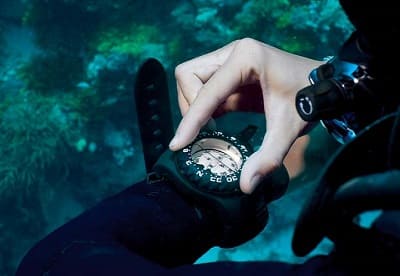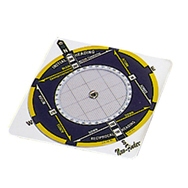Home › Scuba Diving › Equipment › Appliances › Underwater Navigation
Underwater Compass Navigation Tools
Scuba divers use an underwater compass and natural navigation (e.g. observation techniques) to help them reach a destination point when diving.
This guide contains a list of underwater navigation equipment used by divers, with simple tips for beginners about how to use a compass to navigate underwater.
What is Underwater Navigation Equipment?
Divers learn how to navigate underwater in entry-level scuba courses, albeit to a limited degree.
This kind of orienteering is a matter of training and familiarity with the use of underwater compasses, combined with:
- Accurate measurement of short distances (e.g. coral health surveys).
- Air pressure consumption (rule of thirds) and time.
- Kick cycles (one complete upward and downward sweep of a fin kick).
- Various observational techniques for estimating distance underwater.
Pro Tip: Freedivers see the importance of compass in diving as mostly unnecessary, due to the short time periods spent underwater. Plus, the limited distance that surface supplied divers can travel also places less significance for using an underwater diver navigation device.
PADI Scuba Diving Navigation Courses
Underwater navigation is the common reference term for navigating skills and techniques learned by scuba divers so they can accurately traverse underwater environments.
It is a core component of advanced training for recreational divers. For example, the PADI® Advanced Open Water Diver requirements include a mandatory navigation dive skill that involves underwater compass navigation.
The PADI Underwater Navigation Specialty course contains three (3) scuba training dives that focus on underwater search patterns, such as the expanding square and the semi-circular sweep.
Underwater Navigation Tips
There are several reasons why scuba divers learn how to use a diving compass during their training. Not only does successful orienteering underwater help to build confidence in a diver, it also:
- Helps to reduce energy and air consumption (e.g. minimises excess swimming).
- Makes the dive planning strategies more effective.
- Enhances the scuba diving buddy system by keeping dive groups closer together.
Beginners will find it easier to separate the skills into three types, being natural, instrument, and a combination of the two - called practical navigation.
Pilotage (Natural Navigation)
Scuba divers use a similar referencing process to the one that mariners use in pilotage, or piloting. In other words, divers orient themselves using observable landmarks and natural features, such as:
- Bottom contour and composition (e.g. sand ripples running parallel to the shoreline)
- Man-made reference points
- Noise (e.g. boat engine, marine invertebrates, snapping shrimps)
- Sun angle, shadows, and variations in light intensity
- Underwater topography, coral reefs, geological features, and rock formations
- Water movement
Compass Navigation
Instrument navigation (e.g. using a scuba diving compass underwater) is the most popular technique that novices use for distance estimation and orienteering.
 Even though a compass navigation tool is commonplace, and relatively accurate, other devices and mechanisms include:
Even though a compass navigation tool is commonplace, and relatively accurate, other devices and mechanisms include:
- Calibrated distance lines (e.g. cave line markers)
- Dive gauges to identify depth variations
- Open reel tape or surveyor's tape measure
- Pacing distance on the bottom (with your arms)
Practical Navigation
In most cases, some kind of combination of the two methods (a hybrid version) will be best for most recreational divers.
Hence, we use diving compasses to navigate longer distances and in poor visibility, and natural navigation between topographical structures, marine life habitats, and other man-made landmarks.
Here's the thing:
Often, returning to a specific place is important for safety. In this case, divers lay a distance line in place and leave it there for other divers to use, before recovering it on the final return leg.
Pro Tip: Using distance lines is standard safety practice for deep wreck penetration dives and for cave and cavern diving. In fact, being able to make an ascent directly to the surface would be impossible in these hazardous diving environments.
How Do You Use a Compass when Diving?
A magnetic compass is a reliable navigational tool because it works by indicating the local direction of the ambient magnetic field (the Earth). Thus, pressure changes, decreased visibility, and the presence of water do not affect its use.
Following these simple steps will help you use an underwater diving compass in a reliable and effective manner:
- Point the lubber line (a fixed reference mark) in the direction that you intend to travel and then read the number at the bottom.
- The number refers to the magnetic heading that you will travel.
- Hold the compass level. In fact, tilting it causes the internal card to swing and hit the sides. You want to let the card turn freely.
- Keep the compass pointed directly ahead (forward) in a straight line between you and the destination point.
- Remember, metal objects can attract the north-seeking arrow of the compass, which will skew the reading.
Pro Tip: It can be difficult to read the graduations on an analogue compass in low visibility. However, the display on a digital compass can be clearer and it uses a magnetometer to detect the magnetic field of the Earth.
Equipment for Navigating Underwater
Magnetic compasses are one the most common and cheapest scuba diving accessories that divers use to navigate their way around. You can buy them as a wrist mounted device or pre-set in a diver's console. Other tools that can be used to plot an ongoing course during a dive include:
 Cave and wreck reels and line
Cave and wreck reels and line- Compass navigation board
- Hand-held sonar
- Jump spools
- Nav-Finder
- Scuba Sextant
- Underwater search equipment
Using the PADI Nav Finder
A course plotter, or nav-finder, is used in scuba diving to track a multi-heading course and then return to the start point. You can also use the complex patterns to find your way from one of the points to another, or for:
- Looking for hidden treasure.
- The search and recovery of lost items.
- Recovering boat equipment.
The direction is determined using a magnetic compass. The distance can be measured by noting either the 'time' or 'kick cycles'. Thus, divers need to swim at a constant speed to get maximum accuracy.
Pro Tip: The latest developments in underwater GPS tracking for scuba divers are improving each year. In fact, modern technology knows the exact latitude and longitude of a diver and it can display a map of the underwater terrain (where available).
Related Information and Help Guides
- Best Dive Knives 2024 Reviews by Private Scuba Testers
- Best Examples of Surface Signalling Devices Used by Divers
- List of Scuba Dive Equipment with Reviews for Beginners
Pro Tip: The short video tutorial [8:51 seconds] presented by Divers-Supply explains more about basic scuba diving compass use and underwater navigation techniques for new and experienced divers.